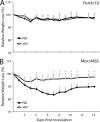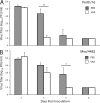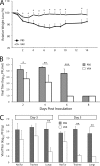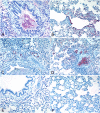Seasonal trivalent inactivated influenza vaccine protects against 1918 Spanish influenza virus infection in ferrets
- PMID: 22553323
- PMCID: PMC3416326
- DOI: 10.1128/JVI.00674-12
Seasonal trivalent inactivated influenza vaccine protects against 1918 Spanish influenza virus infection in ferrets
Abstract
The influenza virus H1N1 pandemic of 1918 was one of the worst medical catastrophes in human history. Recent studies have demonstrated that the hemagglutinin (HA) protein of the 1918 virus and 2009 H1N1 pandemic virus [A(H1N1)pdm09], the latter now a component of the seasonal trivalent inactivated influenza vaccine (TIV), share cross-reactive antigenic determinants. In this study, we demonstrate that immunization with the 2010-2011 seasonal TIV induces neutralizing antibodies that cross-react with the reconstructed 1918 pandemic virus in ferrets. TIV-immunized ferrets subsequently challenged with the 1918 virus displayed significant reductions in fever, weight loss, and virus shedding compared to these parameters in nonimmune control ferrets. Seasonal TIV was also effective in protecting against the lung infection and severe lung pathology associated with 1918 virus infection. Our data demonstrate that prior immunization with contemporary TIV provides cross-protection against the 1918 virus in ferrets. These findings suggest that exposure to A(H1N1)pdm09 through immunization may provide protection against the reconstructed 1918 virus which, as a select agent, is considered to pose both biosafety and biosecurity threats.
Figures




Similar articles
-
Efficacy of seasonal live attenuated influenza vaccine against virus replication and transmission of a pandemic 2009 H1N1 virus in ferrets.Vaccine. 2011 Apr 5;29(16):2887-94. doi: 10.1016/j.vaccine.2011.02.014. Epub 2011 Feb 21. Vaccine. 2011. PMID: 21338676
-
Comparison of a live attenuated 2009 H1N1 vaccine with seasonal influenza vaccines against 2009 pandemic H1N1 virus infection in mice and ferrets.J Infect Dis. 2011 Apr 1;203(7):930-6. doi: 10.1093/infdis/jiq144. Epub 2011 Jan 21. J Infect Dis. 2011. PMID: 21257740 Free PMC article.
-
A single dose of inactivated influenza virus vaccine expressing COBRA hemagglutinin elicits broadly-reactive and long-lasting protection.PLoS One. 2025 Feb 21;20(2):e0308680. doi: 10.1371/journal.pone.0308680. eCollection 2025. PLoS One. 2025. PMID: 39982912 Free PMC article.
-
Immunogenic and protective properties of the first Kazakhstan vaccine against pandemic influenza A (H1N1) pdm09 in ferrets.Virol Sin. 2012 Dec;27(6):345-52. doi: 10.1007/s12250-012-3272-7. Epub 2012 Nov 9. Virol Sin. 2012. PMID: 23180289 Free PMC article.
-
Modeling human influenza infection in the laboratory.Infect Drug Resist. 2015 Aug 31;8:311-20. doi: 10.2147/IDR.S58551. eCollection 2015. Infect Drug Resist. 2015. PMID: 26357484 Free PMC article. Review.
Cited by
-
Influenza vaccination accelerates recovery of ferrets from lymphopenia.PLoS One. 2014 Jun 26;9(6):e100926. doi: 10.1371/journal.pone.0100926. eCollection 2014. PLoS One. 2014. PMID: 24968319 Free PMC article.
-
H5N1 influenza vaccine induces a less robust neutralizing antibody response than seasonal trivalent and H7N9 influenza vaccines.NPJ Vaccines. 2017 Jun 8;2:16. doi: 10.1038/s41541-017-0017-5. eCollection 2017. NPJ Vaccines. 2017. PMID: 29263872 Free PMC article.
-
Stockpiled pre-pandemic H5N1 influenza virus vaccines with AS03 adjuvant provide cross-protection from H5N2 clade 2.3.4.4 virus challenge in ferrets.Virology. 2017 Aug;508:164-169. doi: 10.1016/j.virol.2017.05.010. Epub 2017 May 26. Virology. 2017. PMID: 28554058 Free PMC article.
-
Animal models for influenza viruses: implications for universal vaccine development.Pathogens. 2014 Oct 21;3(4):845-74. doi: 10.3390/pathogens3040845. Pathogens. 2014. PMID: 25436508 Free PMC article. Review.
-
Pathogenesis and transmission of human seasonal and swine-origin A(H1) influenza viruses in the ferret model.Emerg Microbes Infect. 2022 Dec;11(1):1452-1459. doi: 10.1080/22221751.2022.2076615. Emerg Microbes Infect. 2022. PMID: 35537045 Free PMC article.
References
-
- Baras B, et al. 2011. Pandemic H1N1 vaccine requires the use of an adjuvant to protect against challenge in naive ferrets. Vaccine 29:2120–2126 - PubMed
-
- Baras B, et al. 2011. Longevity of the protective immune response induced after vaccination with one or two doses of AS03A-adjuvanted split H5N1 vaccine in ferrets. Vaccine 29:2092–2099 - PubMed
-
- Barker WH, Mullooly JP. 1980. Impact of epidemic type A influenza in a defined adult population. Am. J. Epidemiol. 112:798–811 - PubMed
-
- Belser JA, Szretter KJ, Katz JM, Tumpey TM. 2009. Use of animal models to understand the pandemic potential of highly pathogenic avian influenza viruses. Adv. Virus Res. 73:55–97 - PubMed
MeSH terms
Substances
LinkOut - more resources
Full Text Sources
Other Literature Sources
Medical

